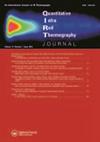Deep learning based thermal image segmentation for laboratory animals tracking
IF 4.9
3区 工程技术
Q1 INSTRUMENTS & INSTRUMENTATION
引用次数: 12
Abstract
ABSTRACT Automated systems for behaviour classification of laboratory animals are an attractive alternative to manual scoring. However, the proper animals separation and tracking, especially when they are in close contact, is the bottleneck of the behaviour analysis systems. In this paper, we propose a method for the segmentation of thermal images of laboratory rats that are in close contact during social behaviour tests. For this, we are using thermal imaging – a technology that requires neither light nor human presence. The aim of the study was: (1) an efficiency analysis of deep learning based image segmentation algorithms for the need of laboratory rats images, (2) analysis of different methods of original thermal data conversion to grey scale images for the purpose of the segmentation, (3) evaluation of the image data range impact on segmentation results using deep learning networks. We have trained U-Net and V-Net architectures with images obtained from different temperature ranges. The results indicate, that networks trained on images containing a narrow range of temperature data equal to animals’ body temperature or even its part, are able to better perform the object segmentation than networks trained on the original data.基于深度学习的热图像分割用于实验动物跟踪
摘要实验室动物行为分类的自动化系统是人工评分的一种有吸引力的替代方案。然而,适当的动物分离和追踪,尤其是当它们密切接触时,是行为分析系统的瓶颈。在本文中,我们提出了一种方法来分割在社会行为测试中密切接触的实验室大鼠的热图像。为此,我们正在使用热成像——这是一种既不需要光也不需要人在场的技术。本研究的目的是:(1)基于深度学习的图像分割算法的有效性分析,以满足实验室大鼠图像的需要;(2)分析将原始热数据转换为灰度图像的不同方法,以进行分割;(3)使用深度学习网络评估图像数据范围对分割结果的影响。我们已经用从不同温度范围获得的图像训练了U-Net和V-Net架构。结果表明,与在原始数据上训练的网络相比,在包含与动物体温甚至其部位相等的窄范围温度数据的图像上训练的神经网络能够更好地执行对象分割。
本文章由计算机程序翻译,如有差异,请以英文原文为准。
求助全文
约1分钟内获得全文
求助全文
来源期刊

Quantitative Infrared Thermography Journal
Physics and Astronomy-Instrumentation
CiteScore
6.80
自引率
12.00%
发文量
17
审稿时长
>12 weeks
期刊介绍:
The Quantitative InfraRed Thermography Journal (QIRT) provides a forum for industry and academia to discuss the latest developments of instrumentation, theoretical and experimental practices, data reduction, and image processing related to infrared thermography.
 求助内容:
求助内容: 应助结果提醒方式:
应助结果提醒方式:


